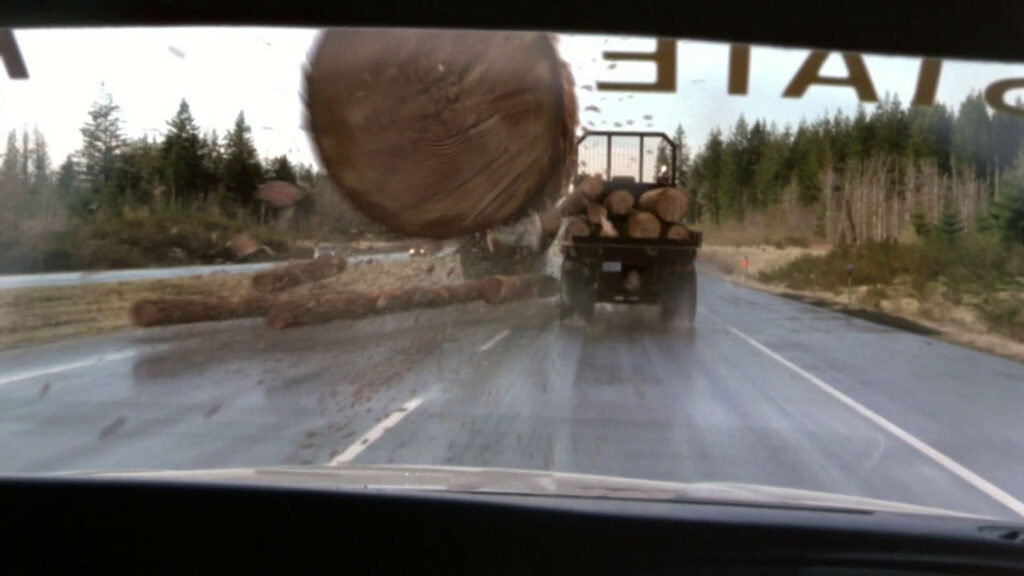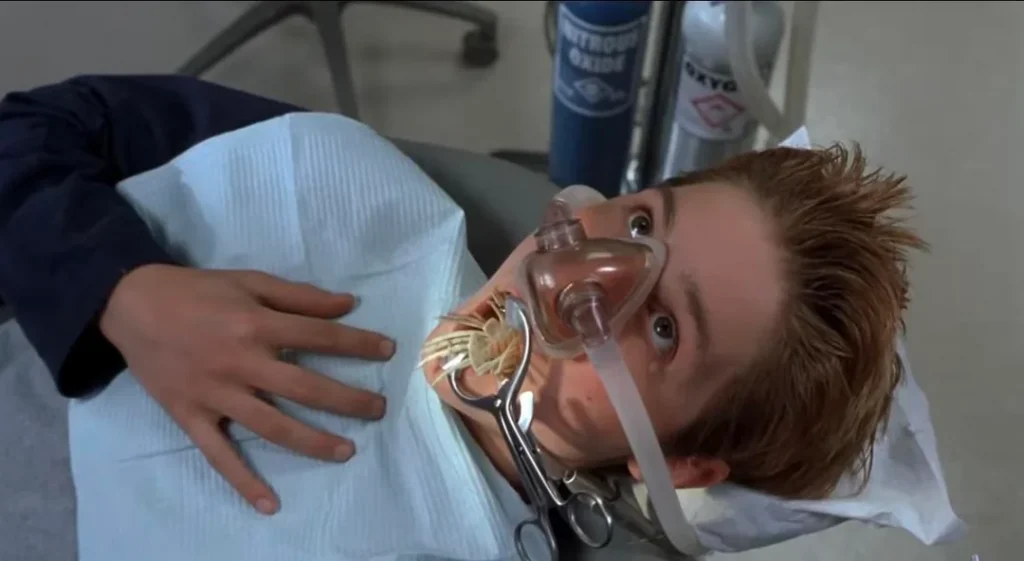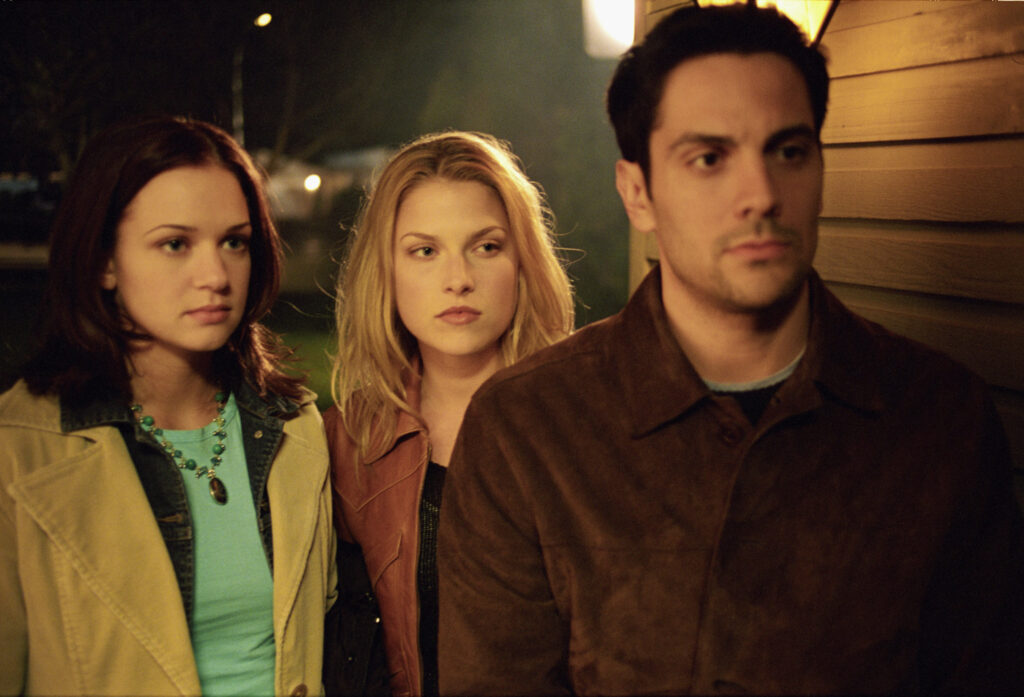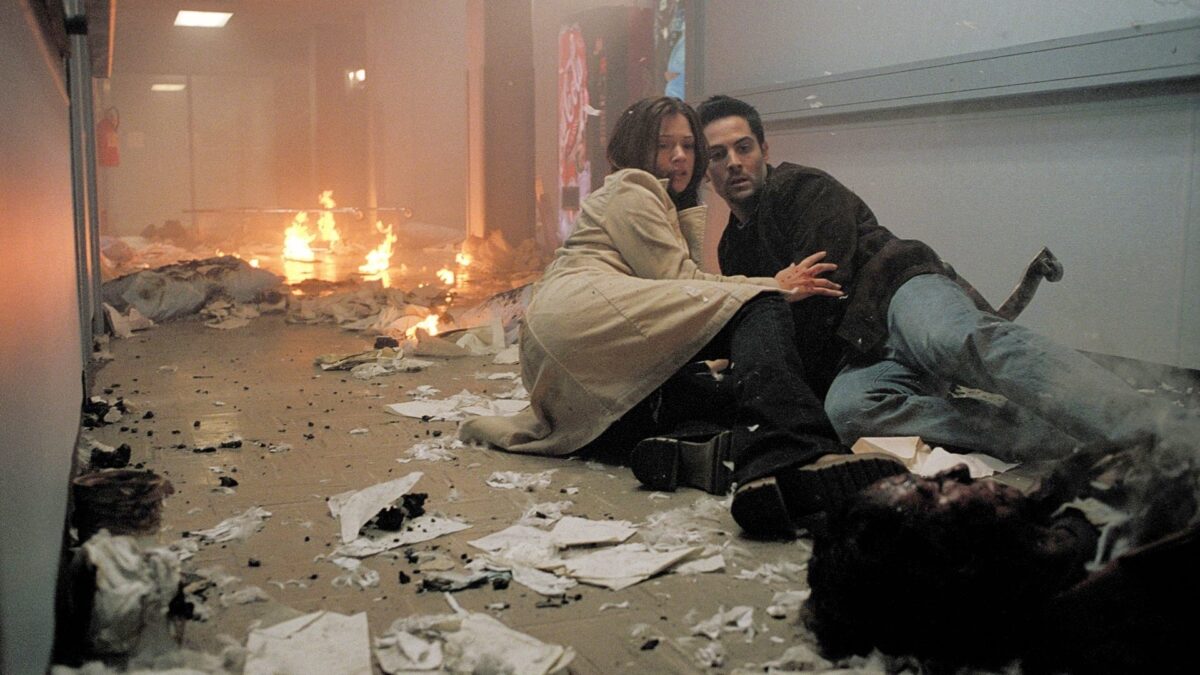Wombo combo, that ain't Falco
It is a hallowed tradition for the second movie in a slasher series to extend or repeat the original with more polish, more creative mutilation, more murders, more nudity, and more all-around fun. It’s a sequel — gotta have more! This rule of severed thumb applies at a minimum to the two biggies: Halloween (whose second outing gets an unfair rap) and Friday the 13th (whose second outing is arguably the series’ peak). I’m sure it’s true of others I haven’t binged yet. And it’s definitely true of Final Destination 2, a follow-up that ups the ante on its predecessor’s Rube Goldberg death promise, and does so with pizazz.
That said, I don’t think Final Destination 2 is a better film than the original, though it at least gives a convincing argument. It plays the sequel game well: bigger set pieces, more confident voice, and a few standout sequences canonized by slasher-hounds. This is an entertaining, quick-moving, check-every-box kind of sequel. But some underlying heft is missing. The first Final Destination was not exactly deep cinema, but it had a peculiar resonance with its teen-angsty meditations on mortality. This one treats death more like a puzzle to fall into place. It’s tense and on the right side of the gore-misery line I discussed recently re: Novocaine, but it has no qualms going full theme park ride. (Speaking of which, I understand “theme park ride” is an element of Part 3).
A big part of that downgrade comes from the film doubling down on the uninteresting narrative thread from the second half of Part 1: the logic puzzle to deduce who is going to die next. The characters spend most of the runtime scrambling to interpret blurry premonitions and untangle Death’s murder algorithm. They read tea leaves based on the sequencing of violence in the original disaster. I get the need for something for the characters to investigate — there wouldn’t be much to do if the story boiled down to “yep, we’re fucked.” I guess it’s a fun gimmick in theory to set up a kooky reverse-order twist as a variation on the original. But honestly the logic of figuring out the order people will snuff it is all obtuse and distracting from the basic matter and themes at hand: death is coming, we cannot stop it… and for those who survived the opening scene, it’s coming in BIG.

The film opens, like the first, with an elaborate mass casualty event. This time: a freeway pileup that has haunted a generation of log truck passersby. Kimberly Corman (A. J. Cook) (yes, another horror director tribute name) is our new lead, headed out for spring break with friends when she has a vision of the carnage to come — lumber flying off trucks, vehicles flipping, metal crunching, fuel combusting, and bodies squishing. It’s a stunning and involved set piece, by reputation the high watermark of the series. Kimberly “wakes up” a few minutes in the past, before the crash starts, panics, and blocks traffic to inadvertently save a handful of strangers.
In a twist on the first film’s formula, Kimberly’s friends still die (crushed by a semi while they wait on the shoulder), and it’s other would-be victims she delays who are now marked for doom. The rest of the film follows this new crop of survivors — including cop Thomas (Michael Landes), stoner Rory (Jonathan Cherry), mother-son pair Nora (Lynda Boyd) and Tim (James Kirk), expectant mother Isabella (Justina Machado), and lotto winner Evan (David Paetkau). Those basic types are basically all we get for character development for the lot. We also reunite with Clear Rivers (Ali Larter) as they drop one by one to Rube Goldbergian freak accidents in the days following their miraculous car crash survival.
Final Destination 2 amps up the “intrusive thoughts” flavor of deaths this time around. It doesn’t just ponder “What if you died?” but “What if you died doing something banal, like discarding leftovers or going to the dentist’s office?” The film weaponizes our most passive routines and observations, especially those that might idly trigger visions of fear: elevator doors, airbags, fire escapes, cargo strapped to vehicles. It brings a dash of understated nihilism — everyday tasks bleed us dry and wear us to the bone, literally.

Since each one is essentially a self-contained thriller in itself, here are mini-reviews of each of the death scenes. That’s the reason we’re all here. In order of operations:
- Route 23 pileup: A true ballet of devastation. It’s a masterclass in cross-cutting mayhem, with practical effects and CG that mostly hold up. But I admit this scene had been hyped a little too hard for me; I had a little “that’s all?” feeling when it concluded. Still, it’s a symphony of destruction. The first half of the scene sets up all the characters and vehicles and dangers, with images of danger that both presage actual violence and set a tense mood. The chain reaction kicks off when a log flies off of a lumber truck and soars through Thomas’s windshield and skull. Within moments, the freeway resembles hell, with flames and flying debris left and right, dozens dead. It finally ends with a huge semi (brilliantly designed so its grill resembles a devil) soaring through the flames and smashing Kimberly, as she promptly “wakes up” from her premonition a moment before she would turn onto the highway.
- Evan’s death: The first post-disaster death of the film really sets the cadence that the rest of the film will iterate upon: A bunch of possible death mechanisms introduced, only for something minor or unrelated to do the victim in. Here, Evan is making dinner. He tosses some old spaghetti out the window. As he gets his hand stuck in a garbage disposal, his cooking catches on fire, which he tries to put out from afar, triggering an apartment inferno. Neither the fire nor the home appliance ends Evan, though. After escaping out of his burning building, he slips on the spaghetti he threw out, and the ladder from the fire escape impales his head. Great buildup with a darkly comic payoff; a major highlight.
- Tim’s death: Probably the most tense and blackly funny death through the first two films. Tim’s visit to a dentist’s office already puts you in a vulnerable headspace, but his appointment escalates from mild discomfort to full absurdity. He’s drugged with nitrous oxide; birds straight out of the ‘63 Hitchcock film try to crash through the office window; a plastic hanging mobile gets briefly lodged in his throat; various explosive tanks and electric wires threaten to ignite… and then the dental staff restores order and gets the appointment back on track and cleans Tim’s molars. Only after Tim leaves the office and chases after some pigeons by a worksite next to the building does he meet his doom — a glass pane pancaking him into fleshy pulp. It’s shocking, stupid, and flawless.
- Nora’s death: Easily the most viscerally upsetting of the bunch. Following a group debate about how to avoid death, she panics as she gets on an elevator. A plastic hook catches her hair as she tries to step off the elevator, and her head ends up inside while her body is outside. Cue the ding of the doors, and… decapitation, her head clunking around like someone dropped a watermelon at the grocery story. Curiously, Nora only dies because she believes she’s about to die. It turns the death curse into a self-fulfilling prophecy, which is not quite in sync with the rest of the deaths here.
- Kat’s death: This one is all about its rhythm. The group gets into a car wreck and Kat gets stuck under a tree log smashing through her car, narrowly avoiding her. She also nearly dies to a jagged PVC pipe puncturing the rear windshield. But the scene pulls back from the deathly vibe for just long enough for us to suspect she’s safe when her airbag abruptly activates and propels her head through the pipe. The pacing is what makes Kat’s death shocking rather than the misdirection of various dangers or the creativity of the violence. It’s a good jolt to keep the murder cadence from getting too stale.
- Rory’s death: The strange rhythm of deaths continues during the same scene as Kat’s death. For the first time in the franchise that I can recall, we have a double-death scene. Some gasoline detonates, and a barbed wire fence soars towards stoner Rory, slicing him into three sliding hunks of deli meat. It’s the double punchline factor of the scene that makes this one memorable besides the gory practical effect.
- Clear and Eugene’s death: The climax stumbles a bit. There’s a multi-scene dose of misdirection and foreshadowing and double-backs, and then — boom — an oxygen-rich hospital room ignites and kills both Clear and Eugene. Eugene’s lead-up is harrowing (trapped in a hospital bed, suffocating, unable to reach the call button), but Clear’s death feels like a cheap surprise. I wasn’t attached enough to mourn her demise, though, and the film seems ready to write her off, too.
- The peek-a-boo ending death (Brian): Like the first movie, the second ends with a scene that seems briefly at peace until someone suddenly dies in the last shot. The survivors are celebrating their continued existence at a barbecue picnic; they’ve cracked the code that a chance survival of sure-death necessitates an actual death. One character recounts a recent near-death experience they survived, and a moment later a grill propane tank explodes, instantly charring grill-master Brian. His severed, medium-rare arm soars through the air and lands on his mother’s plate. Roll credits. Great, funny, nasty finale.

As you can see, by sheer volume and variety, the deaths in Part 2 outmatch those in the original. They’re more intricate and far more committed to the bit. This makes for a sharper execution of the franchise’s central conceit — that Death isn’t just inevitable but spitefully creative — and on that front, it delivers. That said, there’s a creeping sense that the film is a little too into its own mechanics. The fakeouts are so abundant they start losing punch. The more times it leans into convoluted setup and delayed payoffs, the less fun the trick becomes, though the credits roll before it really loses steam.
David R. Ellis steps in as director and brings flair to the physical choreography and pacing of these set pieces. He also amps up the effects, with some really outstanding production. This comes in both prosthetics — squashing and/or splitting bodies — and in vehicle stunts and copious explosions. That said, he doesn’t have much use for any emotional interiority to the characters. I’m happy the series has embraced its identity, but I’ll reiterate it’s a bit hollowed out. Part 1 made room for teen angst and the terror of realizing life doesn’t come with a guarantee, which ultimately had a life-affirming shine to it even amidst the bleak violence. Part 2 skips straight to the body count. As for the acting? We’re at least a tier down across the board. Cook, Landes, and the rest are game, but we’ve gone from B-list to C- and D-list. Hey, what can you do? It’s a horror sequel.
I do get why this entry is often crowned the series peak. It’s slicker, faster, bloodier, and funnier — the kill-centric sequel lovingly executed. And as a horror watch-along or group movie night pick, it’s an absolute crowd-pleaser. But for me, the diminishing returns are already creeping in. The balance of tones is already slipping. I’m entertained, but I’m also bracing for fatigue. That doesn’t bode well for Parts 3 through 6, but I’ve enjoyed my time enough so far to stay optimistic. I’m keeping my mind open… and my car far away from lumber trucks.
Is It Good?
Good (5/8)
Dan is the founder and head critic of The Goods. Follow Dan on Letterboxd. Join the Discord for updates and discussion.


5 replies on “Final Destination 2 (2003)”
I recall seeing the second and third entries in this series – no wait, I also recall seeing the first – on television, but not in the correct order.
Not planning to see any further entries in the series – the world is bleak enough without the Grim Reaper being characterised as creatively malevolent (One gets the suspicion that this franchise’s version of Death actively encourages these little ‘blips’ in their coverage in order to have an excuse to exercise some cruel imagination*).
*My take on The Inevitable is much more like the one mentioned in the old folktale in which the deceased talks about how they ran Old Bones a merry chase all over the Fertile Crescent and the Grim Reaper simply replies “No. For you I have always been here.”
Oh, also, I recently watched FEAR STREET: PROM QUEEN on Netflix and thought that you might like a caution – it may well be the most obvious C+\B- film that I’ve seen (Not badly made, but mostly lacking the spark of life that makes for screaming good fun).
I have the Fear Streets queued up and will check them out at some point. I’ve heard nothing but anti-enthusiasm for FS: PQ, so my hopes are not high.
I’d say FEAR STREET as a whole lives in the good-not-great niche, but certainly has it’s pleasures.
This one is my favorite, but 1 is an absolutely respectable choice, and maybe it really does have a bit more soul.
The subsequent three are not very good–and will have even less soul in what amounts to a sort of active, deliberate way–but all of them will at least have a setpiece or two that’s good.